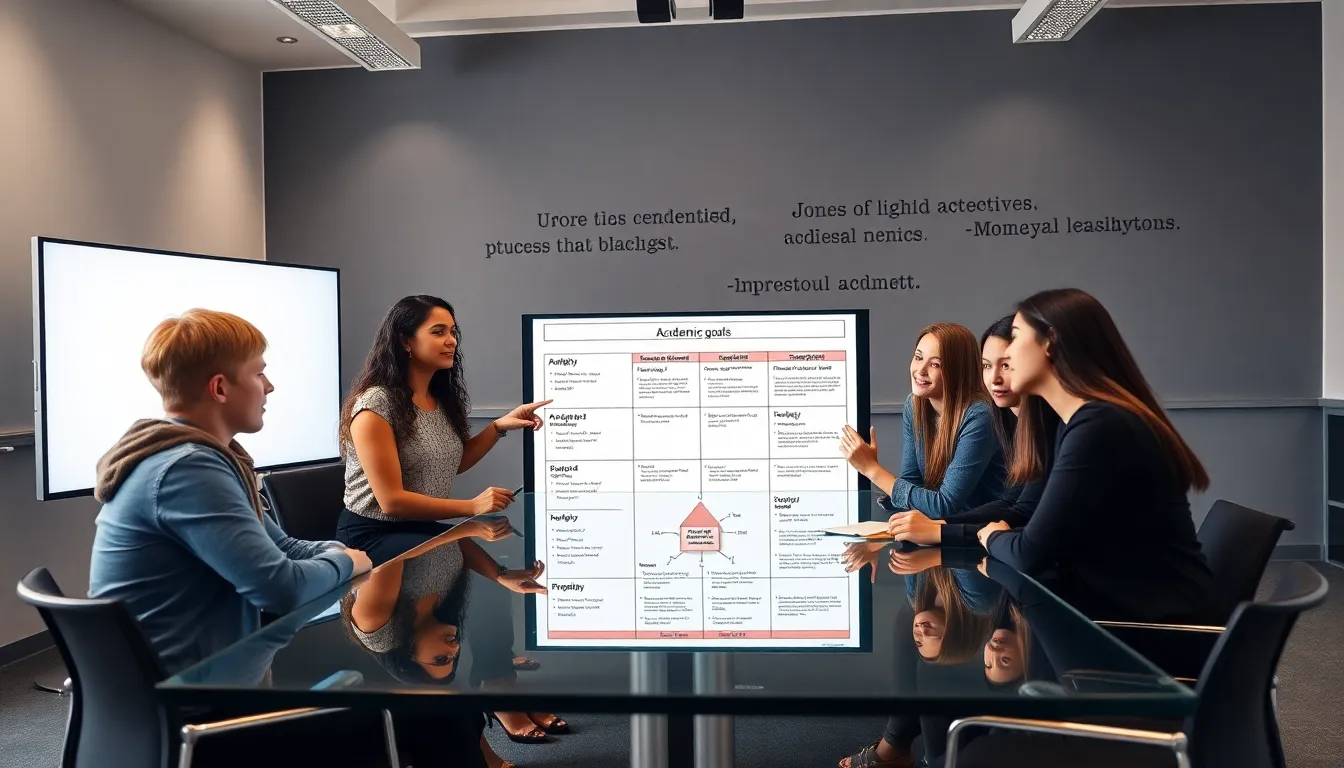Table of Contents
ToggleGoal setting is a bit like GPS for students, it gives direction, helps prioritize, and ensures no one ends up lost in the academic wilderness. Whether you’re striving for the perfect GPA or aiming to master that tricky math concept, having a clear plan makes all the difference. So, grab your favorite pen and let’s jump into how a student goal setting template can transform scattered aspirations into achievable milestones. After all, why drift along when you can steer your ship?
Understanding Goal Setting

Goal setting is more than just jotting down what one hopes to achieve. It’s a structured approach to defining where one wants to go and how to get there. When students understand what goals are, they can better visualize their paths. A goal is a specific, measurable outcome that one is striving for, be it academic excellence or personal growth. And yes, the more specific the goal, the better. This clarity cuts down on ambiguity and boosts motivation. By transforming vague aspirations into tangible objectives, students can focus their energy efficiently. It’s the difference between saying, “I want to do well in school” and “I aim to improve my math grade from a B to an A by the end of the semester.” The latter is precise, actionable, and, most importantly, attainable.
Understanding the why behind setting these goals adds an extra layer of motivation. Goals provide purpose and direction, positioning each student as an active player in their educational journey.
The Importance of Goal Setting for Students
The importance of goal setting for students cannot be overstated. Research indicates that individuals who set clear goals are more likely to achieve them. For students, this isn’t just a motivational poster slogan, it’s a proven strategy backed by science. When students engage in setting goals, they develop essential skills like time management, self-discipline, and resilience.
Also, having defined goals can lead to higher academic performance. When students know what they are working towards, they tend to exhibit increased focus and commitment. It fosters a sense of ownership over their education. Breakthrough moments occur when a student finally grasps a complicated concept or achieves a desired grade. Setting goals gives students the mental framework necessary to secure these victories.
Besides, in an era where distractions abound, having well-defined goals acts as a guiding star. It helps students navigate their academic responsibilities while maintaining a healthy balance with extracurricular activities and social lives.
Components of an Effective Goal Setting Template
An effective goal setting template is like a roadmap to success. It’s essential to incorporate several core components so that students can maximize their chances of achieving their goals. First, a good template should prompt users to define their goals clearly. This means digging deep and specifying exactly what they want to accomplish.
Next, it should include a section for measuring progress. This is vital because tracking milestones helps maintain motivation. Whether marking off completed tasks or noting test scores, seeing progress can fuel further effort.
Another critical element is timeframes. Goals without deadlines can stagnate. By establishing a deadline, students create a sense of urgency that can motivate them.
Finally, including a section for potential obstacles can prepare students for challenges. It’s crucial to recognize that the path to achieving goals is often winding. Subjecting barriers to analysis allows for proactive planning on how to overcome them.
Step-By-Step Guide to Using the Template
Using a student goal setting template is straightforward, but it works best when students follow a systematic approach. Here’s a step-by-step guide for maximizing its effectiveness:
- Identify Goals: Begin by brainstorming a list of academic and personal goals. What does success look like?
- Specify: Choose one or two main objectives to focus on. For instance, instead of aiming to “study more,” opt for “dedicate 30 minutes daily to math practice.”
- Set Timelines: Establish realistic deadlines for each goal. Completing that math improvement by the end of the semester, for example, gives clarity.
- Measure Progress: Use metrics to define success. Track and log results regularly.
- Anticipate Obstacles: Engage in a little creative forecasting. Acknowledge possible challenges and plan solutions ahead of time.
- Stay Flexible: Adapt if needed. Sometimes, life’s curveballs require adjustments to the original plan.
Following this process can enable students to use their goal setting template effectively, turning vague ambitions into achievable realities.
Common Types of Goals for Students
Understanding the common types of goals students typically set can provide valuable insight into personalizing a goal setting template. They can be broadly categorized into academic, personal, and organizational goals.
- Academic Goals: These often include improving grades in specific subjects, mastering a particular skill, or passing an important exam. They serve the primary purpose of enhancing knowledge and performance in school.
- Personal Goals: Personal development is just as crucial. For instance, a student might aim to join a club, develop a particular hobby, or improve their social skills.
- Organizational Goals: These involve honing skills related to time management, study habits, and resource allocation. A student might strive for a more organized study schedule or prioritize tasks better.
Recognizing these categories allows students to tailor their goal-setting approaches for maximum effectiveness.
Tips for Successful Goal Achievement
Achieving goals is not just about setting them: it’s about forming a mindset conducive to success. Here are some actionable tips for students focusing on goal achievement:
- Stay Accountable: Share goals with a friend or mentor. Accountability can make a significant difference in staying on track.
- Celebrate Milestones: Don’t forget to acknowledge progress along the way. Celebrating small victories boosts motivation.
- Create a Vision Board: Visual reminders of goals can keep aspirations top of mind and inspire action.
- Reflect Regularly: Take time to evaluate what’s working and what isn’t. Reflection ensures that one is always steering in the right direction.
- Keep a Positive Attitude: Challenges will arise, but maintaining a can-do spirit can make navigating obstacles much easier.




